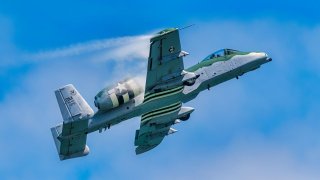Forget the F-16: Why Doesn't America Send A-10 Warthogs to Ukraine?
The A-10 Warthog has a drawback – a fatal drawback – which would render the jet useless in the skies above Ukraine if it was ever called upon to fight Russia.
If you’ve been to the Boise Airport, you’ve probably noticed the distinctive aircraft lining the southern edge of the field. Brownish grey, with straight wings and engines located above the rear fuselage – the A-10 Warthog is hard to miss, especially if you happen to notice the Gatling gun protruding from the nose of the airframe.
The Boise A-10s, assigned to the Idaho Air National Guard, are some of the last 281 A-10s in service – which is why you probably won’t be seeing the A-10 donated to Ukraine anytime soon, even though the A-10 was explicitly designed to kill Russian tanks advancing across the planes of eastern Europe.
A-10 Warthog: Built to kill Russian tanks
Russia has spent the first two years of the Russo-Ukraine War advancing tank columns across the planes of eastern Ukraine – much as war planners envisioned when they commissioned the design and production of the A-10 Warthog in the 1970s.
At the height of the Cold War, common wisdom held that should the conflict turn hot, the Russians would deploy their stockpiles of tanks to execute a land grab in Eastern Europe.
The projections have proven accurate, as Russia has leaned heavily on its tank technology.

Although, Russia’s tank-dependent efforts have not gone well; the Ukrainians have destroyed over 2,600 Russian tanks, often with relatively low-tech defense systems like the FGM-148 Javelin.
If the handheld FGM-148 could wreak such havoc upon Russian tank forces, one might imagine that the A-10’s impact could have been biblical.
The design of the A-10
The modern A-10 is a cantilever low-wing monoplane with a wide chord. The A-10 maneuvers fantastically at low speeds – essential for battle space loitering and close air support – thanks to a large wing area, high wing aspect ratio, and large ailerons.
Able to loiter and operate under 1,000-foot ceilings, the A-10 has proven to be, perhaps, the world’s best close-air support jet.
Another benefit of the A-10’s wing dimensions is the ability to takeoff and land from short-distance airfields, which enables operation from obscure and austere airfields (as are often found near ongoing conflicts). Further, the A-10 was designed to be refueled, rearmed, and serviced with minimal equipment.
The A-10 wasn’t just built to operate from austere environments, but also to survive in hostile environments. Remarkably, the A-10 can survive direct hits from armor-piercing and high-explosive projectiles (up to 23mm).

The A-10 features double-redundant hydraulic flight systems – and should the hydraulic system fail, the A-10 has a backup mechanical system. Also, the A-10 can remain airborne with extensive structural damage; A-10s have remained airborne with just one engine, half of the tail, one elevator, and half of a wing missing.
The pilot is protected, too; the A-10’s cockpit is encased within a 1,200-pound titanium armor shell, known as a “bathtub.”
The titanium plates thickness ranges from 0.5 to 1.5 inches deep and makes up almost six percent of the A-10s empty weight.
Between the ability to loiter and provide close air support, the ability to operate from austere airfields, the minimalist maintenance requirements, and the remarkable survivability, the A-10 seems well suited for engaging frontline Russian targets.
Yet, the A-10 has a drawback – a fatal drawback – which would render the jet useless in the skies above Ukraine.
Don’t expect to see any A-10s above Ukraine
Despite the A-10s strengths – the A-10 is poorly equipped to help the Ukrainians against the Russians.
Why? Ukraine does not have control of the airspace above the conflict – meaning the A-10 would be a sitting duck in contested airspace, vulnerable to air-to-air Russian fighters like the Su-35 and MiG-31.

The A-10 has been successful in past conflicts, like Desert Storm 1.0, Desert Storm 2.0, and Afghanistan – but only after the US had secured the airspace above the conflict zone. The A-10 is a second-phase sort of weapon to be used once air superiority is established.
What the Ukrainians need right now are the tools to establish air superiority – which is where the forthcoming F-16 donations would come into play. But the likelihood of the Ukrainians ever fully establishing air superiority over the conflict is low, meaning the A-10 likely won’t have much value during the conflict.
Yet, even if the Ukrainians were able to secure air superiority, the US is unlikely to donate the A-10. The A-10 is slated for retirement and is no longer being produced. The A-10 is a political football (inspiring heated advocacy both for and against the jet’s retirement).

The Americans are unlikely to maintain A-10 related infrastructure for the purpose of training and enabling Ukrainian pilots to fly the jet.
About the Author: Harrison Kass
Harrison Kass is a defense and national security writer with over 1,000 total pieces on issues involving global affairs. An attorney, pilot, guitarist, and minor pro hockey player, Harrison joined the US Air Force as a Pilot Trainee but was medically discharged. Harrison holds a BA from Lake Forest College, a JD from the University of Oregon, and an MA from New York University. Harrison listens to Dokken. Email the author: [email protected].
Main image from Shutterstock. All other images are from Creative Commons.


